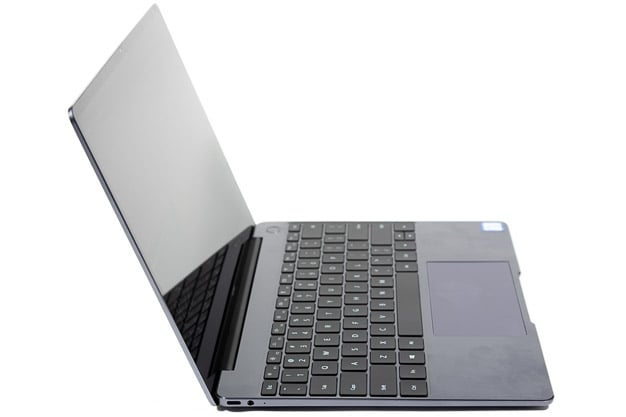Huawei MateBook 13 Review: A High Performance Ultrabook With Caveats
The laptop lid is smoothly milled with the exception of Huawei's logo. The sandblasted finish eliminates any slippery feel but is prone to showing fingerprints and oils, particularly under strong light.
The logo is precision milled as a single piece with the lid. Diagonal cuts cause the logo to catch light differently from the rest of the lid. Sometimes the logo catches more light and appears brighter, and at other angles the lid is more reflective. It is a promising sign of attention to detail.
Once we open the ultrabook, we are greeted by an astounding amount of display. Huawei uses miniscule bezels -- as small as 4.4 millimeters on the sides. Huawei also employs a taller 3:2 aspect ratio to achieve an impressive 88% screen-to-body ratio. The MateBook 13's display is fairly unique among today’s notebooks. Like the Surface tablet, it uses a taller 3:2 aspect ratio. This is generally better suited for working with productivity tasks than a 16:9 or even 16:10 ratio. It displays more lines of text or code vertically and makes working with multiple windows at once a little more comfortable. The trade-off, naturally, is letterboxing in videos.
Its 2048x1440 resolution gives it a very crisp appearance that we find really hits the sweet spot for a 13" device. As an IPS panel, it renders colors very well from any angle. Its blacks cannot compete with an OLED panel, but they are still reasonably dark and offer good contrast. Its maximum brightness is average at around 300 nits. This is bright enough to work outdoors, but direct sun may still create issues.
The webcam placement is equally good. Like the newest XPS 13, Huawei has found a way to squeeze the webcam into the narrow top bezel. This is a much improved revision over the MateBook X Pro's webcam that was located under the F6 key. Granted, the pop-key approach is arguably better for privacy. There is no way to block the webcam in the MateBook 13 beyond a bit of tape.
Below the fold, the MateBook 13 has a fairly standard chiclet keyboard and reasonably large trackpad. The keyboard spans virtually the entire width of the notebook so it does not feel cramped in any way. The key switches are quiet when pressed with minimal travel.
The keys are also backlit, with two levels of brightness available. The glow is soft and easy on the eyes in darkness.
The power button in the upper right corner pulls double-duty as a fingerprint reader. It integrates with Windows Hello for convenience and security. We found it to work quickly and without issue.
Following trends, the MateBook 13 is light on IO. The right side of the notebook features just a single USB-C port.
The left side is nearly as bare with its own USB-C port. At least Huawei has seen fit to also include a TRRS headset jack.
While the exterior is simple and refined, let's take a look at what makes the MateBook 13 tick...















